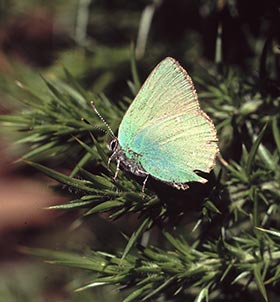Green Hairstreak (Callophrys rubi)
When: Mid to late April until late June or early July
How many: Relatively scarce in the New Forest and often inconspicuous

in typical pose on gorse
Green Hairstreaks are relatively infrequently noticed in the New Forest, although these attractive insects are widely distributed throughout much of Hampshire. Favoured habitats include chalk downland, heathland, meadows and woodlands.
Although usually numbering less than 50 individuals, downland colonies tend to be the most heavily populated; whilst New Forest colonies, found on some of the heaths and, to a lesser extent, in a number of woodland inclosures, are typically much smaller.
The Green Hairstreak flight period lasts from mid- to late April until late June or early July, with peak presence often noticed in late May and early June.
On dull days, they may remain out of sight, hidden away in vegetation, although sunny weather is likely to tempt out territorial males to take up exposed positions on gorse bushes or other shrubs from where the arrival of a female will be patiently awaited. Disturbance, the presence of other competing males or the sighting of a passing female is likely to prompt rapid, sometimes spiralling, erratic flight before eventual return to a favoured perch.
Identification is reasonably straight-forward for these small butterflies invariably perch with wings tightly closed, displaying bright green undersides that are frequently dotted with a row of white marks - the 'hairstreak' - which in some insects may be much reduced in extent or almost absent altogether. Plain brown uppersides to the wings are consequently usually seen only in flight. In marked contrast to many other hairstreak species, Green Hairstreak 'tails' are short or absent altogether. The sexes are of similar appearance.
Gorse is the main caterpillar foodplant on heathland, whilst common bird's-foot-trefoil may also be used, particularly in the New Forest by woodland ride dwellers.
References:
Butterflies of the British Isles: J.A. Thomas
The Butterflies of Hampshire: Matthew Oates, John Taverner, David Green et al
The Millennium Atlas of Butterflies in Britain and Ireland: Jim Asher, Martin Warren, Richard Fox, Paul Harding, Gail Jeffcoate and Stephen Jeffcoate
Insects of the New Forest - Paul Brock
More links
Other related links
Search this site

Sadly, 58 animals were killed - 35 ponies, 13 cows, 8 donkeys and 2 sheep, whilst a further 32 were injured - 3 pigs, 9 donkeys, 11 cows and 9 ponies.
(Forty-three accidents occurred in daylight, 15 at twilight and 101 in the dark. Twenty-seven accidents were not reported by the driver involved).
Here's just one horrific example - Three donkeys killed in collision with van at notorious New Forest blackspot (Advertiser and Times)

